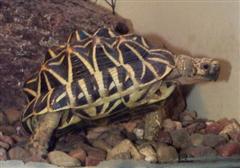Australian snake necked turtle
Scientific Name: Chelodina longicollis
Fri, 29th November, 2024 - 12:36 am GMT
Sponsor Ads:

Alternative Name
Scientific Name: Chelodina longicollisBasic Info
The Australian Snake Necked Turtle has a smooth, long carapace that is mostly oval-shaped, with a small length-wise dip that runs from the top of the carapace to the bottom, complementing the carapace's dark brown, green, or black color. The turtle's neck is nearly as long as its carapace in some cases, but most of this species' carapaces do not extend past 10 inches. The marginal scutes, plastron, and bridge all have dark brown to black markings, complementing a light cream color.
Health
The Australian Snake Necked Turtle is relatively easy to take care of. You will need a large aquarium, with basking space. The temperature needs to be kept at a comfortable 73 degrees Fahrenheit. Some hobbyists suggest keeping the pH of the water in the tank low about 6.5. This may help the turtle's development, and help them avoid some skin problems. Peat or sphagnum moss will aid in lowering the pH of the water naturally. If you live in a warmer environment, the Australian Long Necked Turtle may do quite well in an outdoor pond, preferably one with some plants around to keep its living space shielded from outsiders. In the wild, these turtles feed on mostly on aquatic and semi-aquatic animals like small fish and small amphibians. While captive, your turtle will happily subsist on snails, small fish, and even worms. These turtles do need some extra calcium in their diets, so giving them a piece of cuttlebone might be a good idea. Breeding The Australian Snake Necked Turtle's nesting season begins in late spring or early summer, with the female laying anywhere from 8 to 24 eggs. The incubation period lasts around three to four months.Habitat
Most widely kept and loved turtles in AustraliaBehavior
One of the easiest Australian Turtles to care for, the Australian Snake Necked Turtle is popular among novice and expert turtle lovers alike. The Australian Snake Necked Turtle is one of the most widely kept and loved turtles in Australia. It is also quite popular in other parts of the world. The Australian Snake Necked Turtle is generally shy as a rule, but will adapt quickly to living in captivity and may eventually be one of the most rewarding turtles you can keep as a pet. Turtles that are not used to being handled will often emit a musky odor that dissipates after they become acclimated to being handled. The Australian Snake Necked Turtle seems to adapt well to life in captivity. They become tolerant of handling quickly and even those that are wild caught will eat from the hand within a couple of weeks.Origin
AustraliaHistory
N/ACommon Foods
N/ASponsor Ads:
The good die young -- because they see it's no use living if you've got to be good --John Barrymore
Australian snake necked turtle
Coded by: BGID® | ALL RIGHTS RESERVED Copyright © 2000-2024
Disclaimer | Privacy | Report Errors / Contact | Credits



 Beware the new Naval power, they are planning to come on stream with big naval might to match their ground forces. Chinese Aircraft Carrier - Chinese Navy
Beware the new Naval power, they are planning to come on stream with big naval might to match their ground forces. Chinese Aircraft Carrier - Chinese Navy  versus
versus 
 versus
versus  This Thread is about the North Korean Military itself - the kind of army, navy, and air force they have.
This Thread is about the North Korean Military itself - the kind of army, navy, and air force they have. 
 versus
versus  versus
versus 
 versus
versus  versus
versus